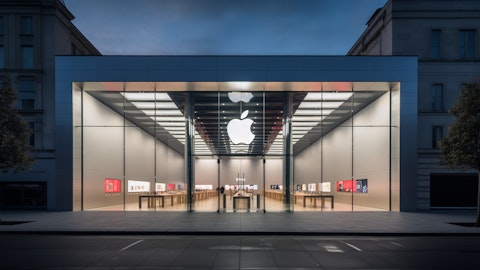Are you basically want to compete with everyone in China? So that’s that for China. And then just on next year, so you kindly commented on the order book. If I look at your total company sales next year, I think consensus is looking for about 8%. You’re going to lose the benefit of Yeezy, which is adding, I think, 3% or 4%. So basically, consensus is assuming kind of a very low type of double-digit type of growth next year underlying. Do you think that’s kind of — I know it’s a bit premature. You’re not going to give us any exact figure, but is it in the realm of possibility, low double-digit organic growth, given what you’ve printed this year or not?
Bjorn Gulden : First of all, China, all products in China are different than the product you have in a different market on the apparel side because they have Chinese specs. So the sizing and the spec are different even if the product looks the same. So you have to think about it. The product is different anyway. And what we have said is that if it’s different anyway, why don’t we let the Chinese decide also more on the design? So we have now 50 designers sitting in Shanghai, which has the freedom to add supplement or create something that we haven’t done before in apparel from older collections. If that is 30% or 40% or 20%, I don’t really care. It is all the Chinese organization that is deciding on that. On footwear it’s a little bit different.
But on footwear, we can produce locally all styles also in China, which is an enormous advantage. And that’s why also there, we give the Chinese the possibility then to add SMUs material components due changes to the collection and produce it locally, which on a landed cost could be cheaper in our duty. And of course, from the lead time when it gets to both transportation and production gives them advantage. That’s why we’re stopping this selling in as much as we can and take back what we cannot sell to a plant business where we say that we only sell in 70% and then the rest, we actually will replenish or put new product into the store during the season of the quarter. So this is a new kind of way of working. When it gets to the market, I think on the performance side, we have been competing, I would say, only against the Western brands and then you’re right, especially Nike.
But the local brands, the Li Nings, the Anta stuff have created, I would say, performance segments underneath €100, which still people are running marathons and playing basketball with them. I think that’s a market that we strategically now are looking at to build, I would say, high-technology product, but at the price point also below what we normally would do for the Chinese market to make sure we’re competing for a bigger piece of the pie. When it gets to the cities, we are obviously competing in the major cities. That’s where we lifestyle wise, I think, for a long time, a market leader. And that’s something we want to grab back again. And there we are competing both against Nike but also other brands. And in the lower tier cities, the distribution is thinner.
We have closed, I think, about 3,000 stores with our partners to kind of clean up a lot of bad distribution, and that’s where neo played a big role. So currently, neo will be reduced to a very, very small part of the business. The brand neo itself will then disappear and then we will have partners that will then attack the smaller cities with a special, what should I say, offering, but in a much more narrow what should I say, process than what we used to do. So it is a little bit what should I say, more details than what you asked. But in general, you will say, yes, neo will disappear. We will find or have found retail partners that will attack the smaller cities with a specific range. And then we will focus with our major partners and on the bigger cities and D2C, don’t forget that our D2C business in China is pretty low.
And then we will try to balance and optimize the offering as good as we can. You have a tendency to try to get a top line guidance, and that’s the way you set up the question. And of course, your math is correct, but it’s very difficult now to say are we shooting for 7%, 8%, 10% or 12%. As I said, in the first half, and again, we haven’t even decided what to do with Yeezy. The first half will have a lower growth than the second half, just naturally. And that’s because the order book, of course, is building as we go from quarter-to-quarter. The U.S. market is lagging behind and will probably not grow at all in the first half. I think we can look at some growth in the second half. And then, of course, it depends on what we do with Yeezy. But underlying, we will have growth, for sure.
But I think we should prove to you that, again, the growth that we are having is a profitable growth, and it’s a growth that we can build on instead of trying again then to convince you with some numbers and then run into overheating the market again. Right now, I think the demand for the second half is going to be very strong. And then the question is how do you face the first half and how do we make sure that we don’t overheat franchises, but that we manage them properly. And I hope you saw that Terrace, then into Campus, then into Superstar, then into 70s running. And then we have a new lifestyle running products behind that. And then all these trends rolled in, what should I say, copy down to other price points. So we have all the ingredients that we actually need to improve during ’24.
But remember, the goal is to be really profitable in ’25 and ’26 and not try to overheat in ’24.
Sebastian Steffen : Andrea, we have time for 2 more questions, please.
Operator: The next question comes from the line of Andreas Riemann with ODDO BHF.
Andreas Riemann : First question on fall/winter24. You said this is the first collection from you and the team, Bjorn. And we know you want a more local product. You want a bit more wholesale, you want to cover more niche categories. So what strategic aspects are already reflected in this fall/winter24 product? This would be the first question. And somewhat linked to that, my second question, other than China, what are the countries where you see the biggest need for a more local adidas product?
Bjorn Gulden : Well, I think what I tried to say is that the ’24 autumn range is the first, what should I say, range that we go to market in a way that I think is right. Remember, I’ve been here for 9 months. So actually setting that up with what products are we showing what customers, how do we show it? How do we sample it, what kind of dialogue have we had with the retailers before we make the collection, how do we go with SMUs and how do we go in in-line product, I feel that autumn/winter24 is closer to what I see as optimal and is the first what should I say, go-to-market process, where I can say, yes, this is the way Adi should be, and I feel good about it. The other quarters before that was chasing business to fill a gap because the order book was down heavily.
So that’s why I’m saying I feel comfortable sitting looking at autumn/winter24 because I’ve seen the reaction. I’ve been in many of the meetings. And with everything we see in the market, God forbid that the world goes into a crisis again, I feel good about that. When it gets to the markets where we need local products, I mean, you definitely need it in India. I don’t know if you know, but the Indian government has put a new regulation that actually forces you to do a lot of local sourcing. And when you do local sourcing, why then also do local product? I mean there’s no need to force designs on people when you have to source it there anyway, then you can also try to do the science that is committed to that market. So India will have a lot of local.
China we already talked about. Then there are needs, especially in Japan and Korea to do trend stuff in a different way. And then I think the big difference and the biggest discussion many retailers have and I guess, brands is what is the difference between the U.S. and Europe? And we know that American street culture is different than the street culture in Germany, what should I say, the basketball and hip-hop influence in the U.S. is different than what it is in Europe. And the differences are bigger than you think. And that’s why for us, we have set up this process and the office in L.A. to target very specifically at the street culture in the U.S. If that product then can go to Europe, fine. But if it doesn’t, then we develop product also here.
So in the future, the sum of, I would say, what we do in China, what we do in India, what we do in Korea and Japan and what we’re doing then in Herzo together with L.A. is then the total of what we do. And then the balance, how much is then global, how much is local, doesn’t really matter because we have the resources. It’s mainly different factories. And again, I think that we can get closer to the consumer, and we can get quicker when we do it that way than trying to sell one collection to everybody. So I don’t think there’s a big disagreement on this, and I think the retailers in the different areas loves us for doing this approach. So I hope that answers your question.
Operator: The last question comes from the line of Cristina Fernández with Telsey Group.





